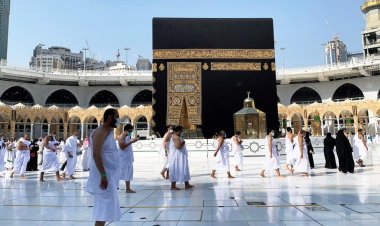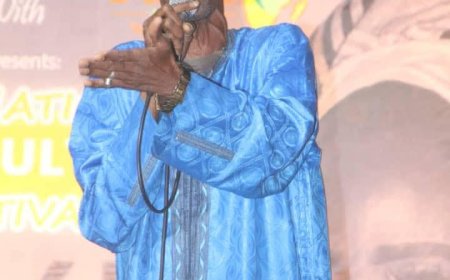ON MAKING A SINGLE AUDIBLE SALAAM WHEN COMPLETING THE PRAYERS

في التسليمة الواحدة في الخروج من الصلوات
One of the things I love most by being in Mali is in the majority of the masaajid in which I pray, the Imams close the prayer with a singular audible salaam by turning their heads slightly to the right and saying: AS-SALAAMU ALAYKUM!
For some reason, which I have not yet put my head around, I always smile at that point in the prayer; not out of heedlessness, or out of thinking about other than completing the prayer with the hope that the prayers of everyone present in the masaajid have been answered...
...but for some inexplicable reason, I feel that I am doing something with my people in congregation that we have always done going back to the days of the Prophet, may Allah bless him and grant him peace...
...something that was lost or died in a great deal of the Umma, but which the Africans kept alive...
In this post, I will try and explain the legal basis and origin of the singular audible salaam when ending the prayer.
The African proofs for the saying of the Tasleema singularly is well known among the Malikis. Our textual evidence is what the scholar of our Jama`at, Shaykh Uthman ibn Is’haq said in his Sulam ‘l-Hudat:
"اَعْلَمْ وَفَقَنَا اللهُ وَإِيَاكَ إِلَى مَا يُحِبُّهُ وَيَرْضَاهُ إِنَّ الصَّلاَةَ عَلَى ثَلاَثَةِ أَقْسَامٍ: [1] قَوْلٍ [2] وَفِعْلٍ [3] وَمَا لَيْسَ بِقَوْلٍ وَلاَ فِعْلٍ، أَمَّا الْقَوْلُ فَكُلُّ مَا يَتَحَركَ بِهِ اللِّسَانُ كَالتَّكْبِيرِ وَالتَّحْمِيدِ وَالسَّلاَمِ، وَأَمَّا الْفِعْلُ فَكُلُّ مَا يَتَحَرَكَ بِهِ الْجَسَدُ كَالرُّكُوعِ وَالسُّجُودِ وَالْجُلُوسِ، وَأَمَّا مَا لَيْسَ بِقَوْلٍ وَلاَ فِعْلٍ فَالْقِبْلَةُ وَالْوَقْتُ وَالنِّيَةُ وَالْبُقْعَةُ"
“Realize and may Allah make you and us successful in what He loves and is pleased with, that the prayer is divided into three parts:
[1] words;
[2] actions;
and [3] that which is neither words or actions.
As for the words, they are every movement of the tongue, like the takbeer, glorification (tahmeed) and the saying of peace (as-salaam).
As for the actions, they are every movement of the body, like the bowing (ar-ruku`u), the prostration (as-sujuud) and the sitting (al-juluus).
As for that which is neither word or action, they are the facing of the qibla, the time, the intention, and the place.”
So clearly from the above the tasleema is included among the first division of the prayer; that is, the words of the prayer.
Shaykh Uthman ibn Ishaq also said:
ثُمَّ اَعْلَمْ أَيْضًا إِنَّ أَقْوَالَ الصَّلاَةِ كُلَّهَا سُنَّةٌ إِلَّا ثَلاَثَةٌ: [1] تَكْبِيرَةُ الإِحْرَامِ [2] وَقِرَاءَةُ الْفَاتِحَةِ [3] وَالسَّلاَمُ، وَأَفْعَالُ الصَّلاَةِ كُلُّهَا فَرِيضَةٌ إِلَّا ثَلاَثَةٌ: [1] رَفْعُ الْيَدَيْن عِنْدَ تَكْبِيرَةِ الإِحْرَامِ، [2] وَالْجَلْسَةُ الْوُسْطَى، [3] وَالتَّيَامَنُ قَلِيلاً.
“Then realize also that all of the words of the prayer are Sunna, except three words:
[1] the takbeer at the commencement of the prayer (takbeer’l-ihraam);
[2] the reciting of the Opening Chapter (qira’at ‘l-faatiha);
and [3] the saying of peace (as-salaam).
And all actions of the prayer are obligatory (fareedatun), except three actions:
[1] raising the hands during the takbeer’l-ihraam;
[2] the middle sitting (al-jalsatu’l-wustaa);
and [3] turning the head slightly to the right during the tasleema.”
Therefore the words of the tasleema are obligatory, but turning the head slightly to the right is not. So now already we can see that one tasleema is indicated in the statements of the Shaykh. We will return to a discussion on the legal status of turning the head slightly to the right after a little, Allah willing.
To further clarify the legal status of the greetings of peace in the prayer, Shaykh Uthman ibn Ishaq said:
ثُمَّ اَعْلَمْ أَيْضًا إِنَّ أَرْبَعَةَ تَجْزأَ عَن أَرْبَعَةٍ، وَأَرْبَعَةَ لاَ تَجْزَءَ عَن أَرْبَعَةٍ: [1] تَكْبِيرَةُ الإِحْرَامِ تَجْزى عَن رَفَعِ الْيَدَيْنِ، [2] وَقِرَاءَةُ الْفَاتِحَةِ تَجْزِى عَن السُّورَةِ، [3] وَالسُّجُودُ عَلَى الْجَبْهَةِ تَجْزِى عَن السُّجُودِ عَلَى الأَنْفِ، [4] وَالسَّلاَمُ تَجْزِى عَلَى الإِشَارَةِ بالرَّأسِ، فَهَذِهِ أَرْبَعَةٌ تَجْزِى عَن أَرْبَعَةٍ، وَأَمَّا أَرْبَعَةٌ اَلَّتِي لاَ تَجْزِى عَن أَرْبَعَةٍ: فَأَضْدَادُهَا.
“Then realize also that there are four things which suffice for four things and there are four things which cannot suffice for four things.
[1] The saying of the takbeer’l-ihraam suffices for raising the hands.
[2] The reciting of the al-Faatiha suffices for reciting the extra sura.
[3] Making prostration (as-sujuud) upon the forehead suffices for making prostration on the nose.
Finally, [4] the saying of the as-Salaam suffices for turning and indicating with the head. These are the four things which suffice for four things.
As for the four things which cannot suffice for four things, they are the opposites of the aforementioned four.”
So from the above, Shaykh Uthman ibn Ishaq verifies that saying of the tasleema is an obligation which suffices for the turning and indicating with the head slightly to the right, which is Sunna, but the turning of the head cannot suffice for the saying of the tasleema.
Shaykh Ibn Ishaq also said in the section on the obligations of the prayer (faraa`id): “The saying of peace (as-salaam) is obligatory.”
What this means and Allah ta`ala knows best is that the fourteenth obligation of the prayer is the saying of peace, which indicates that it is from among the pillars of the prayer (arkaan).
This means that is necessary for the one praying that when he wishes to leave the prayer that he say: as-salaamu `alaykum. This is regardless if the person praying is the imam, the one following (ma`muum) or one praying alone (fadhan).
It is also necessary to say the as-salaam before saying `alaykum, and it will not suffice to just say: `alaykum, or: salaami alaykum; or: salaamun `alaykum; or: `alaykum as-salaamu. Those praying must say: "AS SALAAMU ALAYKUM"
If the saying of the obligatory tasleema is neglected intentionally or unintentionally, by the imam, the one following or the one praying alone, then the prayer is invalidated (butilat) and it must be repeated within its time.
Shaykh Ibn Ishaq said in the section of the sunnan of the prayer:
وَالتَّسْلِيمَةُ الثَّانِيَةُ سُنَّةٌ يَعْنِي بِهَا رَدُّ الْمُقْتَدِي السَّلاَمَ عَلَى إِمَامِهِ
“The second greetings of peace (at-tasleematu ‘t-thaaniyatu) is sunna, meaning the one following (al-muqtadi) returning the greetings to the imam.”
This means and Allah ta`ala knows best that the one following an imam should return the greetings of peace to his imam if he caught a single raka`at with him. This is the case also if he caught more than a single raka`at, but he does not return the greeting if he caught less than one raka`at.
He should indicate the returning of the greetings with his heart silently, but not by moving his head. What is clear is that the only audible tasleema which is obligatory is the tasleema to the right when leaving the prayer. This is further clarified by the following.
Shaykh Ibn Ishaq also said in the same section of the sunnan of the prayer:
وَالتَّسْلِيمَةُ الثَّالِثَةُ لِلْمَأمُومِ يَشِيرُ بِهَا عَلَى يَسَارِهِ إِنَ كَانَ بِهَا أَحَدٌ سُنَّةٌ
“The third greeting of peace by the one following the imam (al-ma’muum), by indicating to his left when there is someone on his left is sunna.”
What this means and Allah ta`ala knows best is that the follower should return the greetings of peace to those on his left side when there is someone on his left who caught a single raka`at with the imam, even if the imam has finished and left, or the one on his left has finished and left the prayer.
It is sunna to return the greetings of peace to him and it suffices in the greetings of peace to the imam and the follower on his left by saying: ‘salaamun `alaykum’ with the indefinite article, or by saying: ‘`alaykum as-salaamu’ by putting forward the statement: `alaykum. However, it is best to give the greeting of peace in the same manner as the obligatory tasleema.
Finally, Shaykh Ibn Ishaq said in the same section of the sunnan of the prayer:
وَالْجَهْرُ بِالتَّسْلِيمَةِ الْوَاجِبَةِ بِأَن يَسْمَعُ نَفْسَهُ وَمَن يَلِيهِ سُنَّةٌ
“The saying aloud (al-jahru) with the obligatory tasleema by it being heard by himself and those next to him is sunna.”
What this means, and Allah ta`ala knows best, that the first tasleema, which is an obligation must be said aloud. As for the returning greetings of peace to the imam, the one following on the left, it is not sunna to say it aloud, rather, the sunna is to say them silently.
Now, let us return to a discussion on the legal status of turning the head slightly to the right during the obligatory tasleema.
Shaykh Ibn Ishaq said in the section on the merits of the prayer (al-fadaa’il):
“Among the merits of the prayer (fadaa’il ‘s-salaat) is turning the head to the right during the obligatory saying of peace (as-salaam).”
What this means, and Allah ta`ala knows best is that the imam, the one following the imam or the one praying alone is not obligated to turn the head to the right, nor is it a sunnan of the prayer, which means if it is neglected then there is no need to make the prostration of forgetfulness (sajda as-sahwi) before the tasleema. This is because the saying of As-Salaamu `alaykum suffices for the turning of the head, as the Shaykh mentioned above in the introduction of the Sulam’l-Hudat.
The spiritual master of our spiritual masters, Shaykh Ahmad al-`Alawi said in his al-Manhu al-Quduusiyya:
“The tenth obligation of the prayer is the salaam; and it means returning to creation after having been consumed in the presence of the Absolute Being. It is thus necessary for the person of this spiritual station that they direct themselves towards creatures with their outward, not their inward and address them with their audible tongues and not their hearts.
This is because the heart has a singular direction – ALLAH…It is thus necessary for the person of this immense spiritual station that they speak to creation with their tongue; and this is what is meant by their saying: ‘AS SALAAMU ALAYKUM’. This is an obligation for them.”
It is as if the person praying is saying that while my tongue greets creation with the the greetings of peace, my inner heart remains in the Presence of the Absolute Being (AL-HAQQ) the Author of Peace (AS-SALAAM); as one of the wise sages said in poetic verse:
فُؤَدِي عِنْدَ مَحْبُوبِي مُقِيمٌ يُنَاجِيهِ وَعِنْدَكُمْ لِسَانِي
“My inner heart is with my Beloved firmly established
Having intimate converse with Him, while my tongue is with you all”
Now as for our proofs from the prophetic traditions for saying a single tasleema turning the head slightly to the right is what was related by Imam at-Tirmidhi in his Jaami` on the authority of Hisham ibn `Awra on the authority of his father, `Awra on the authority of A`isha who said:
“The Messenger of Allah, may Allah bless him and grant him peace when he used to give the greetings of peace in the prayer he would make a single tasleema turning his face slightly leaning towards his right shoulder.”
Imam Muhammad ibn Abd’r-Rahman said in his Tuhfat’l-Ahwadhi Sharh Jaami` at-Tirmidhi:
“Some of the people of knowledge have said regarding the greetings of peace (at-tasleema) in the prayer, that the soundest opinion (asahha ‘r-riwaayaat) from the Prophet, may Allah bless him and grant him peace is two tasleema.
And most of the people of knowledge from the Companions of the Prophet, may Allah bless him and grant him peace, the Taabi`uun and others after them held to this opinion. However, there are some of the people from the Companions of the Prophet, may Allah bless him and grant him peace and others who held to the view of a single tasleema in the prescribed prayers.”
This was the view held by Imam Malik, may Allah be pleased with him, and those who follow the people of Medina. Imam as-Shaafi` said: “If you like you can make a single tasleema or if you like you can make two tasleema.”
With the ending of the statement of Imam as-Shafi`, may Allah be pleased with him, I end this post regarding the question about the legal proofs of making a single tasleema in the prescribed prayers.
And success in what I said is from Allah ta`ala and peace and blessings be upon the master and seal of the prophets and messengers, our master Muhammad, his family and Companions. O Allah be merciful to the entire Umma of Muhammad, with an all encompassing mercy, may Allah bless him and grant him peace.
www.siiasi.org


















































